Welcome to the inaugural edition of “Saladin’s Sundrarium,” a new weekly feature here on Tor.com! The “rules,” such as they are, are simple: Each week I’ll be bringing you a brazenly subjective and personal list of Top Five (or Six or Seven or ) ridiculously specific geekicana.
Your mission, should you choose to accept it, is to let me know what a nerd culture genius I am for including Item X and/or what a moron I am for failing to include Item Y. My hope here is to nurture a good-naturedly boisterous discussion of things geekical that is somewhere between a Wordsworthian-Coleridgean dialogue and a dwarven tavern brawl. So please do have at it in the comments!
Anyway, without further ado, I give you:
Five Iconic 1st Edition AD&D Illustrations Proving David A. Trampier Is One of the Best Fantasy Artists of All Time
Though hardcore enthusiasts of old-school RPG art consider the tags “DAT” and “TRAMP” to be the familiar mark of an Old Master, many folks who grew up worshipping the Holy Trinity of 1st edition AD&D—Monster Manual, Player’s Handbook, Dungeon Master’s Guide — have never heard the name David A. Trampier. But such folks would certainly recognize Trampier’s work.
Trampier’s style was an essentially unique blend of cartoonishness and realism. If the legendary Errol Otus, with his rough-hewn, dynamic line drawing, was D&D’s Jack Kirby, Trampier was its Neal Adams. His art bridged the kineticism of earlier, more “primitive” artists with the hyper-slick realism of later artists like Larry Elmore and his generations of imitators.
Here are a few of my personal favorites among Trampier’s pieces:
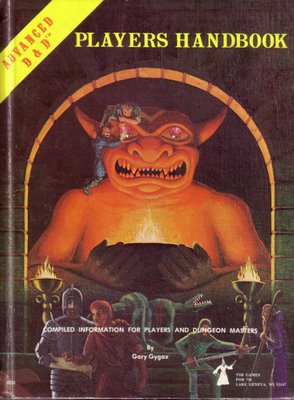
1.) The cover of the 1st edition Player’s Handbook. A motley crew of adventurers, the bloodied bodies of lizard men, the hint of arcane malevolence surrounding the idol, the daring thieves prying the jewels from the statue. This is arguably the most iconic piece of art in all of RPGdom.
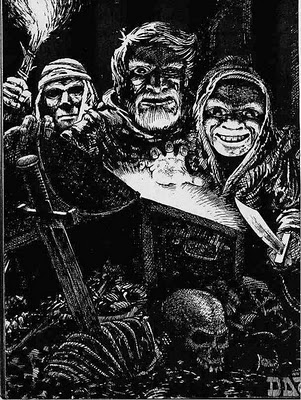
2.) “Treasure!” This image sums up that sweet, sweet, payoff moment when the monsters have been vanquished and the gold is there for the taking. Like the glowing briefcase in Pulp Fiction, we don’t need to know what’s in the chest—we only need to know that it’s almost impossibly awesome. And yet the sword-skewered skeleton in the foreground, the graspy hands and greedy eyes of the adventurers There is a clear hint here that there is more danger in store.
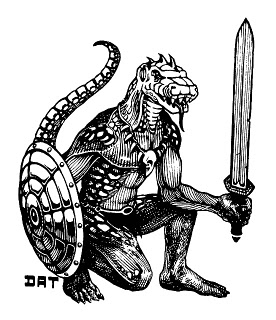
3.) Lizardman. Whether he was drawing the veins on an intellect devourer or the barbed tail of a pseudo-dragon, Trampier’s illustrations were always tactile in a way that most old-school RPG art wasn’t. Here the lizardman’s slithering black tongue and the gleaming plates of his shield look real enough to touch, but not so slick that the illustration loses its vitality.
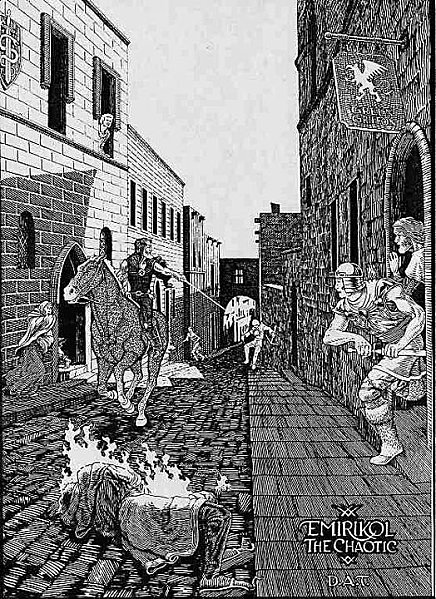
4.) “Put down your flagons, boys! Emirikol The Chaotic’s coming this way!” A whole generation of gamers wondered about this anti-hero’s story. The lovingly depicted brickwork here is great, but I really dig the western movie pastiche. It’s as if the baddest outlaw of ’em all just rode into town and the lawmen at the Green Griffon saloon rush out to give him what form only to get causally zapped by a Finger of Death.
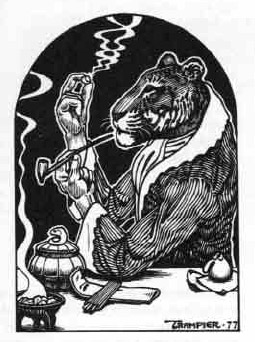
5.) Rakshasas. When I was a kid, this picture annoyed me, but I couldn’t stop looking at it. Rakshasas were ultimate badass monsters. So why was this guy just SITTING THERE, SMOKING!? Why wasn’t he eviscerating some 3rd-level fighter, or at least brandishing his claws or arcane energy in a fiendishly threatening manner? Only as a grown man did I read the great Nigerian writer Wole Soyinka, who said, “A tiger does not proclaim his tigritude. He pounces.” And, Trampier reminds us, a rakshasa doesn’t gnash his teeth—he sits there in his sharp as hell smoking jacket until it’s time for him to feast upon your still-living flesh.
The above images all come from the 1st edition’s Big Three books. But Trampier’s art also appeared in modules and ads. And he was the creator of the beloved Dragon Magazine comic strip Wormy, which starred a cranky, pool-playing, cigar-smoking dragon perpetually annoyed by adventurers. The strip ran for over a decade, form 1977 to 1988.
And then things got weird.
In 1988, in the middle of a storyline, Wormy suddenly stopped appearing in Dragon. Uncashed checks for the strip were returned to TSR, and Trampier moved without leaving a forwarding address. To this day, no one seems to know what exactly caused this sudden departure from the industry, though a number of folks with inside knowledge have indicated that Trampier was deeply dissatisfied with his treatment by TSR.
Fast forward fifteen years, when an article about a wizened cab driver named David Trampier appear in Carbondale, Illinois’s Daily Egyptian accompanied by this photo.

The pic bore enough resemblance to DAT’s often-bearded heroes that some people wondered. And investigated. And sure enough, it was him.
Apparently, after the article appeared, Trampier was approached by a number of fans, and even folks looking to hire him. They were all met with polite but firm refusal and requests to be left alone. It seems unlikely, then, that the world will ever see new art by this titan of the gaming industry.
Sad as that is, the man’s left an impressive legacy. If you played 1st edition AD&D, chances are that you remember Trampier’s work, even if you didn’t know his name until now. So which of these iconic images perform a deadly strike to your nostalgia’s pressure points?
Saladin Ahmed was born in Detroit. He has been a finalist for the Nebula and Campbell awards, and his short fiction has appeared in numerous magazines and podcasts. His debut fantasy novel Throne of the Crescent Moon is forthcoming from DAW Books.










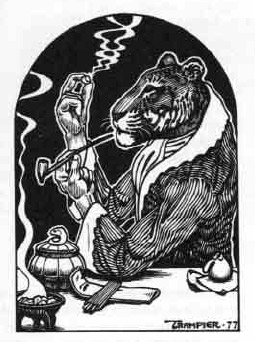
I love old-timey tabletop RPG art– well, old-timey tabletop RPGs as well. There’s just something bizarrely fascinating about flipping through books like that, poring over tables and reading magic item descriptions. If you’re a certain kind of geek like me, then looking through a table describing (for example) a Rod of Wonder is more stimulating to the imagination than a thousand words of flavor text.
I have always loved the Players Handbook cover and the Rakshasas. Never occured to me they were from the same artist. I don’t know how old I was when I got the Players Handbook but that one and Dungeon Master’s Guide mesmerized me. Fantastic stuff. I remember thinking “those guys are nuts, stealing that eye. Bad shit is right about to go down.” Which summarizes the feeling of just about every RPG I’ve ever played….greedy bastards make bad shit happen. Ya know? That cover nailed it.
Of all of the images in the books the Rakshasa was always my favorite. Classy, savage. As if to say, “I’ll get to tearing your heart out in a moment, but first I’m going to smoke a bowl. Care for some?”
I would say that my first dungeon adventure included a raksasha but then I would be admitting that I was a DM. I just loved the urbane, colonial vibe. (The players got to him and only then did I realize I had put a monster way above their experience level and the whole experience was about to become exceedingly Not Fun. Then one of the players piped up, ‘How about a game of chess? You win, you eat me. I win, you get an evening’s entertainment.’ Good players will save DMs ass.)
At the time I was playing AD&D with those books, it never occurred to me to wonder about the artists behind the iconic art. Thanks for giving us a little more information about the artist behind the art!
I remember enjoying all of those pictures. I, too, was caught by the Raksasha. But I think that of all of those you discuss it was the image of Emirikol that I stared at the longest, enjoying the detail and wondering about various expanations for the events depicted. Was he good, or evil, or crazed? Where was he headed at such speed — deeper into the city, or out its gates? Any number of stories could have sprung from that moment.
If you like that, check out some of his science fiction gaming illustrations, too. In particular, he apparently had a lot of fun with the first-edition “Gamma World” rulebook illos (as a high school sophomore, I had a photocopy of his hisser illo on my locker wall), and I was really surprised to see how much work he did on the side for TSR’s “Star Frontiers” supplements, too.
As for his leaving and refusing to come back, I admire his fortitude, because the nagging can be intense. I can state from personal experience that the temptation to return can be irresistable, on the idea that you won’t get screwed over again. Giving in never, ever, turns out well.
I was five or six when I first looked at these and they fired the imagination. I remember thinking everyone who said D&D was devil worship was full of crap because I thumbed the books (I couldn’t play yet) and there was no such nonsense to be had, just things to bring enjoyment and wonder.
Lovvvve that treasure image. The sword, the skull, the glow… Particularly when I played as an early high-schooler, so much of the game WAS oriented around getting as much treasure as possible, so this illustration complicates that motivation in a really neat way. If we’re aspiring to be different characters, do you REALLY want to be that rogue, with his gleefully repulsive grin?
Thanks for the information. I never realized they were all from the same artist–that’s really cool.
For me, it is a tie between “Treasure!” and the Lizardman. One of my first characters was based on the Lizardman illo (the product of a horribly unbalanced effort to make a PC race/class for it). “Treasure” is just perfectly iconic.
I love the Rakshasa, but that picture of Emirikol the Chaotic inspired DnD campaigns!
Goodness… every one of those pictures struck a chord in me and reminded me of the times when I was 8 and I would “borrow” my brothers books and flip through to the illustrations.
It was fantastic illustrations like the Rakasha that inspired me to become the artist and old school gamer I am today. :)
Not a D&Der, but I’ll look forward to telling you what a genius/moron you are in future weeks.
I used to spend hours copying drawings from my brothers D&D manuals. One of many stepping stones that lead me to Tor. Thank you Mr.
Trampier.
I actually made characters for each of the figures in the “Treasure!” illustration: a young thief, a grizzled old fighter, and a ranger :) Seeing the pic again is a definite blast from the past!
Looking at these images, I just got time-warped back about 2 1/2 decades. The PHB cover has been imitated many times since it came out but it’s still just as you say – iconic.
I can only imagine what TSR could’ve done to sour somebody so badly that he refuses to even entertain job offers some 15 years later.
Wow – I kind of figured there’d just be tumbleweeds rolling through the comments. Thanks for all the great memories, guys.
Ian – yeah, the old DMG in particular, with its ‘Everything in the universe can be made into a percentile dice table!’ approach was absolutely rife with storytelling possibility.
Jason and Jack – WotC are still getting mileage out of Trampier’s idol lo these many years later. I just saw an ad for an online D&D game that used it.
Maureen – I’m sure your sense of DM-ing balance was better than my 11 year old boy sense of it. Someday I’ll tell you about the time I got myself out of a total party kill by suggesting my little brother’s magic user stick a fireball wand up Orcus’s butt.
Stephen – Heh. Let’s just say the bowl-smoking Rakshasa became much cooler to me in my late teens…
Howard – A few enterprising souls have statted out Emirikol, but he’s cooler as a mystery. Ethos-wise it’s kind of interesting – he seems to be a holdover from the white box D&D, when ‘chaotic’ was an alignment.
Paul – I was never big into SF gaming, but I did love this Trampier pic from Gamma World.
Scott and JStarr – That’s the pic that flashes in my mind’s eye whenever I get paid for a job. :)
Thanks, all, for dropping by!
Coincidence: I’m going to be in Carbondale, IL this weekend. I’ll be too busy to chase down random cabbies and have too much respect for his privacy anyway.
So many to choose from … his late Wormy strips showed a breathtaking attention to detail and draftmanship. Backgrounds in an underground city for a one-page conversation between supporting characters, e.g., lovingly rendered a complete three-dimensional space populated by distinct individuals.
While I might understand withdrawing from a particular employer, I don’t understand refusing to republish or complete a work of art, when there is clearly an audience capable of bankrolling it. That is unfortunate.
That rakshasa always seemed to me like it would have the voice of the terrific actor George Sanders.
A little late to the conversation, obviously, but I wanted to make one more point about the rakshasa illo: he’s holding a live coal in his fingers! Talk about badass…
I have loved Trampier’s work for 30 years now.
It is his visuals I think of when I think of D&D.
And Wormy…well Wormy was, is, tremendous.
Artist Donato Giancola actually has three orginal Trampier drawings hanging in his house. Any NYers at his anual open house, be sure to check them out.
Greyhawk Grognard – Totally. Sanders’ Shere Khan is one of the best bits of villanous voice acting ever recorded…
A couple of years back I bought the 4th Edition rules. I don’t play D&D anymore, but I wanted to “keep in touch” with things.
I found the art . . . well, lurid. Too colorful and rich. The monsters were kind of over-the-top grotesque.
The old B&W art, by Trampier and Erol Otus and many others, was very cool and evocative.
The Idol picture is so iconic, that the White Wolf folks did an homage to it for the cover of one of their supplements for Exalted.
I recognized it immediately and grinned.
Alright, I’ll call one you missed, my old favourite of DAT’s: the Intellect Devourer. Looking like a coffee table from the Addams Family, the muscular legs of the literally brain-on-legs creature was just…creepy.
There could not be a more perfect quote to go with that picture, which is my favorite by a long shot. Even knowing that guy wants to reduce me to a stack of fleshy cubes doesn’t stop me from wanting to hang with him. He’s just that cool.
@@@@@ CaitieCat – Yeah, that one really grossed me out as a kid. Check out those toenails!
You’re missing three of my favourites:
1) The back cover to D3, in which the PCs encounter Drow, and one gets a spear through the heart.
2) The cover to the original Basic Set (with the blue book), which is the thing that got me hooked on RPGs in the first place.
3) Descending the stairs, and encountering a Magic Mouth.
I wish you’d posted some art from Wormy, particularly the arc featuring the winged panther.
His use of color in some of his Wormy art had an almost Maxfield Parrish-like quality.
The Emirikol drawing is based on a real location: the Street of the Knights on the island of Rhodes.
Jon – Wormy felt like a study unto itself. But yeah, the last panel here is just jaw-dropping.
Sue – Some of the module art and Dragon ads are less familiar to me. But every time someone shows me one of those pieces it’s as if I remember it, even though I know I’ve never seen it…
The uncanny magic mouth drawing (which was from the DMG IIRC?) always struck me as a bit goofy, but that’s most likely because, as a youngin, I considered the spell itself goofy…
Have you seen the parody of/homage to Emirikol The Chaotic in Hackmaster 4th Edition? Very cool.
Man, these take me back to high school! I wanted to play so much, but I was the only one to who could actually write adventures and DM, so I never really had the experience of a player character. I wonder if I could find those old adventures …
Ah, good ol’ DAT!
Funny you should use the word “titan”, because DAT also had his hand in co-creating the well-known game called “Titan” which went on to become a very well-known computer game of the same name.
http://en.wikipedia.org/wiki/Titan_(game)
Having upgraded from the basic D&D game, I can’t even tell you the effect that new AD&D game had on me and my imagination, and it definately started when I set my eyes on the complex and Gyaxian theme embedded into cover of the Players Handbook, and the many well-thoughtout black and white inks drawings in the tome.
I’ve never played Titan, though it looked fun.
One of the rumors about Trampier’s beef with TSR is that he wanted to expand into game dsgin but was basically told to stay in his little artist box. No idea whether this is true or not…
Absolutely LOVE his stuff! He will forever define the look of D&D for me.
oh, the upcoming Goodman Games Dungeon Crawl Classic has an interesting “60 seconds afterward” homage in it you might enjoy:
http://www.goodman-games.com/forums/viewtopic.php?f=13&t=2699&view=next
I agree with CatieCat – there have been plenty of great illos of lizard men and goblins throughout the years but that first drawing of the intellect devourer is still the best. I have yet to see anyone top it (and I’m a lifelong hardcore D&D nerd so I spend a lot of time looking at pictures of monsters).
The creepy brain bristles with psionic energy and alien intelligence and recalls the form of a coral or fungoid growth. At the same time, those wicked claws tell a completely different story – a savage bird of prey mercilessly tearing into soft, yielding flesh.
My favorite D&D artist. He managed to evoke Albrecht Durer, MC Escher, and other classic artists in his work, when most of his fellows were just drawing monsters.
As much as I respect his desire for privacy, I think he’s made a mistake setting aside his talent, regardless of the original cause. I believe that when God gives us a gift, we are supposed to use it, and the use of it will be a source of joy. Art didn’t cause his pain— people did.
(By the way, I’ve heard from sources with an inside track that part of DAT’s disappearance had to do with the failure of his marriage as well as disputes with TSR (which by this point had also booted Gygax, which suggests DAT’s beef with upper management was legit). I imagine the culmination of events lead to a desire on DAT’s part to break from his past and completely rewrite his life, including an absence of all contact with gaming, fantasy and art. Rumor and speculation, of course, but if true, a sad choice to feel one has to make.)
Chello!
Great article! Here’s a bit of trivia for you. The street used in the Emirkiol picture is based on the Street of the Knights on the island of Rhodes.
http://batintheattic.blogspot.com/2010/09/imagining-d-for-myself.html
Unfortunately, Emirkiol was headed for a dead-end.
http://batintheattic.blogspot.com/2010/09/more-on-emirikol-chaotics-ride.html
There have been many homages to the idol pic. The Hackmaster cover, D&D “all editions” pic, one of TSR’s hobby shop catalog cover (done with teddy bears), even the Mouse Guard RPG. It is iconic.
Oh, and do I have to say that Emirkiol is my favorite?
:D
Jon above had mentioned the Rhodes connection. But the fact that someone bothered to plot out that route is awesome as awesome gets.
This looks like a great feature. I need to think of a top list for you!! In the meantime, I admit to recognizing all five of these pictures.
The quality of the art in those books still rivals anything TSR/Wizards has done since was almost directly why I still loved D&D. This guy and Erol Otus were my most favored artists…they were not the technically brilliant or particularly realistic ones, but they captured the “spirit” of the game better than any I have seen. Those original books (which I still have) even inspired my boys (both raised in the instant gratification world of computer games and dvr tv) to play, and they prefer the original books to peruse over the 4.0 books I tried to like.
I miss wormy, and my boy fell in love (I bought the dragon magazine cd archives) with the series…it still forms a core part of his personal mythology…
If I had to choose a favorite Trampier piece, I would likely go with the Fire Giant from the AD&D Monster Manual, who had just such a sense of the … solidity … that a giant should have. Massiveness depicted in lines of black ink so well that I would fear to encounter such a creature.
Also, some mention should be made of the collage illustration for the AD&D Dungeon Master’s Screen, one of the few full-color Trampier pieces produced and which seemingly includes a self-portrait of the artist as the knight in the lower right with upraised sword protecting the damosel in distress. Another iconic AD&D product, methinks.
Of these, I like the lizardman the best. But I’d put these two ahead: The wererats and the remorhaz.
/@@@@@
Timothy – that’s encouraging to hear, re: your sons. I think lots of contemporary RPG art is gorgeous, but I do wonder whether all the full-color “Now with more fangs and buckles!” ‘extreme’ art has desensitized the newer generations to the pleasures of B&W art.
Eugene – Yeah, I love the helmet and armor on that fire giant pic. Tramp just knew how to draw metal.
Ant – It was a very close call for me between the Rakshasa and the wererats. Both illos combine the human and the bestial so masterfully…
While Tramp’s Rakshasas is an iconic image from the original MM, the one thing that no one ever mentions is the fact that he didn’t draw the hands of the creature correctly. The hands of a Rakshasas are backwards and in Tramp’s illustration, they’re both drawn as if normal hands.
Two of my favorites of his were his depictions of the Fire Giant and the iconic Lich.
Brian makes a good point. I can’t recall, though, whether that folkloric bit of rakshasa anatomy is actually part of the MM1 description.
I’d totally forgotten that the lich was also DAT’s work. Also had a buddy remind me that the displacer beast was as well… The hits just keep on comin’!
Thank you for that wonderful story Saladin.
The impact of artists like David on the generation of gamers, whom I am a part of, is incalculable.
They brought the world of D&D to life, populating it with our dreams, fantasies and horrors. But most importantly, they provided an authoritative source for us to point to and state ‘ I am not alone in this pleasure to create fantasy art’. They paved the road for artists like myself to have a flourishing career in the arts.
Thank you David, for making my dreams come true.
Donato
Donato – as a fan of both the old and the new, let me just say that you’re a very worthy inheritor. Love your work!
One word:
Salamander.
@TWGrace: I always thought that one would make a boss tattoo.
I grew up with the red box D&D set, so Larry Elmore’s dragon art made a big impression on me. I’d seen most of the 5 images before (especially remember the rakshasha), but hadn’t connected them with the same artist. I also used to enjoy Wormy.
Orcus anyone? Orcus?
Who remembers the type five demon??? So sexy!
Is that a Bolotomus from the Tom Wham boardgame Snit’s Revenge in the lower right hand part of the Rakshasa illustration? Looks like the Rakshasa is using him for a paperweight!
http://boardgamegeek.com/image/483306/snits-revenge
Tramp was the man, hands down. He is right there with the Hildebrandt bros (Sword of Shanarra covers) as my favorites over the years (with Frazetta being a good representation of the next tier down, where his stuff was a bit “too much”, too fantastic, not eartly enough for me).
I brought up the thing about Titan game (above ) he helped design because of this: he was more than an “artist”, per se. His drawings were not just that of superior technical skills to that of his peers, but it was also very much about what he chose to draw. He has a far better understanding of what should be drawn. I believe he thought out the settting and the mood he wanted to express moreso than the others, and what image he wanted to evoke with his work. He put more planning and/or was more inspired in his work. The rest of the bunch seemed to just consider what they did as mere “piece work”.
Makes me wonder what kind of superior artwork we would’ve had for many more years had not TSR management treated this guy with the respect and admiration he was due.
In his work, in my opinion, he was at his best when employed the black and white ink work, and usually, all the surfaces had a texture to them, which I loved. They looked almost like woodcuts. It is very concise and exact work, and compared to the others in which he shared space in a given work, his stuff always stood out from the rest. No knock against DCS III, Wham, Pekul, et al, but I could never figure out why DAT wasn’t given more covers and interior work after the PH and MMI. In the 1e DMG, it seemed like he drew almost nothing, and I remember seeing the DMG cover for the first time, that it was a good job for sure (some of DCS’ best), but were DAT given the job, you would’ve had something amazing I think.
Everyone liked Wormy, but to me that seemed like more of a waste of his skills, too cartoonish, where it more about quantity and not quality, where DAT was about the exact opposite.
Though other aspects of each product is important to various degrees (designing, writing, editing, etc.), but since the RPG games are really ones of the imagination itself, it cannot be underestimated what impact the artwork has on the overall results of the RPG products, whether rulebooks, modules, worldbooks, etc.
He may be out there somewhere, soured by the play of events, but his work will live forever.
For a game that was pretty much all in your head it is amazing how important DAT’s art was to me and my friends. The cover pics on the player’s handbook and 1st addition rules and some of the other monster pics really inspired a lot of our RPG adventures with my middle school group around 1980ish. I love the old style black and white sketches… less is more, leaves a lot to the imagination. Very weird that he ended up as a cab driver
I don’t have first hand knowledge but I have been told that the greatest of Tramp’s artwork has been lost. There was a bar in Lake Geneva where all the TSR workers would go after hours. The men’s bathroom was completely covered in grafitti by Tramp and Tom Wham. I was told it was the equivalent of the Sistene Chapel for their work. Unfortunately it was torn down to be turned into an italian restaurant so it has all be lost, but I would have loved a picture.
I’ve heard this from several legitimate sources.
Emirikol.
However, the aforementioned DM screen wraparound “mural” was the best he ever did at TSR, imo. And that is even counting some fantastic scenery he put to paper (or canvas) in Wormy, such as scenes of a giant ranger observing a thundercrack, a giant striding through a ring of fire, a scene where that flying panther carries a wizard “outside” space amidst globes of reality, a large panel of “The Stump” treehouse, the lights of the underground town . . .
Clean. His art was just so damn CLEAN; it told the tale, with vibrancy and that’s all: NO WASTE. All it needed to be, it was, and only what it needed to be. It lived, because of it.
His line work was awesome; his use of color always evocative and only highlighting, never diminishing the b/w framework beneath it; his ability to harken to ancient woodcuts in a much sharper manner than actual woodcuts could achieve, an incredibly clever and useful way to portray “medieval” scenes.
Only a few of the artists who followed at TSR ever impressed me: Denis Beauvais, Kieth Parkinson, a few others. Very few others. Tramp still holds the crown in spirit, even if he did toss it back.
Never noticed the Escher angle that Parzival mentioned, but wow, it is hard not to notice now! Figures that Escher is also one of my faves.
Figures that Donato loves Tramp’s work. Donato is nothing short of brilliant. One of the best of the best; a serious artist who studies the old masters’ techniques and compositions, and makes copies of his line work to vigorously test out various color combinations before committing to a final product.
Tramp may have put down the brush for public art (hopefully he did not deprive himself of it!) but let’s hear it for pulling a Gauguin for 15 yrs and counting! Sans tropical isle, of course.
Yeah, his artwork brings back many happy memories.Wish we still played AD&D,just been flicking through the MM,love the Homonculous,the Shrieker and the full page picture,the one with the giant spider about to pounce,.On the right you can see a hand pointing and you can almost hear the yelled,’ Look Out’! Hope he is well and happy,I must have spent hours looking at his drawings and years later I still am …
Hi…as an original D&D player/DM going back to 1978, Dave Trampier at one time offered, for the sum of $20, a stake in his graphic novel of collected WORMY strips. Unfortunately, everything went as if Emirikol the Chaotic had his hands in it, not to mention the flying black panther from WORMY, for Dave’s plans came to naught. Dave did send me back my money, along with a button he had made. As nice a guy as he was talented.
Trampier was/is my favorite fantasy artist…all those images mentioned etched themselves in my young 12 year old mind….he is a real Master, and has a great understanding of movement and action, linework, expression…a gifted artist, as is Donato
I always felt that the early Artist’s of D&D with all their wonderful imagination played a huge part in D&D’s popularity…they captured the imagination…subsequent editions have not fully understood the importance of the Art work in the same way…I remeber talking to Gary Gygax about just such a thing and he agreed…saying many contemporary artwork’s were “punk” without specifying which…but as a classically trained Artist myself, I understood what he meant by that term…to me it meant not solid, rushed, without deep understanding of the old principles…Trampier’s work is old school in the best way…but most of all, it has the magical wonder that one cannot teach or learn…that which comes from the soul of the artist himself…that quality that gives life to your work, gives it a soul….it is a rare gift…
Great article and definitely some of my favorites from his artwork. Also very sad to hear about his death earlier this week. RIP DAT!!
Trampier’s work is absolutely immortal to gamers, especially those who started in the earlier or middling days. His illustrations have long since ascended from the page and etched themselves into our memories and imaginations. And yes, Stefan, even your Dwarven Forge sculptures show the loving inspiration of his work!
Trampier went through some rough years emotionally. There were a few stories. I won’t repeat them, as I don’t remember the details, and it’s just gossip. When you feel you’ve been screwed over, the last thing you want is a reminder, even if it is monetary compensation, of that situation. Trampier did eventually get back into showing his art at gaming conventions. He agreed to show some of his work at a convention, and unfortunately died right before the convention. RIP, DAT. Gone far too soon…
I am an oddball in that I owned many of the D&D books but never actually played the game! My friends were more into playing outside or with Star Wars figures when we were 7-10 years old. But I got so many ideas from the books that fueled my own imagination. The Rakshasa was the most memorable ‘monster’ I can remember, probably due to the fact that he is just kicking back, not appearing menacing. Plus wearing his Hugh Hefner smoking jacket, just looked so cool.
@71 — I am exactly the same oddball as you, except change “owned” to “own”.
And last night I watched the recent movie version of It (which updates the setting of the kids’ story to 1988) and one of the kids had a poster of the Player’s Handbook cover on his wall, and now I WANT THAT POSTER!
70, there’s a lot of folks who wanted to play D&D, but never got to do so, for a variety of reasons, including a lack of friends, parents succumbing to the moral panic, and other things. But for all those who didn’t, it’s never too late to start, and the opportunities now are greater in their way.
71, There are posters available, I’m not sure how official they are, so I won’t link to them, but it’s possible your local comic store may be able to help. Or regular book store.
I actually can’t tell if the Rakshasha’s hands are right though. Or rather wrong.